Leadership Impact on Fonterra: Culture, Vision and Entrepreneurial Thinking
VerifiedAdded on 2023/05/27
|14
|4193
|337
AI Summary
This report analyzes the impact of leadership on organizational behavior, culture, and vision in Fonterra, the world's largest dairy exporter. It also discusses the company's entrepreneurial thinking and creativity, and provides recommendations for expansion and diversification.
Contribute Materials
Your contribution can guide someone’s learning journey. Share your
documents today.
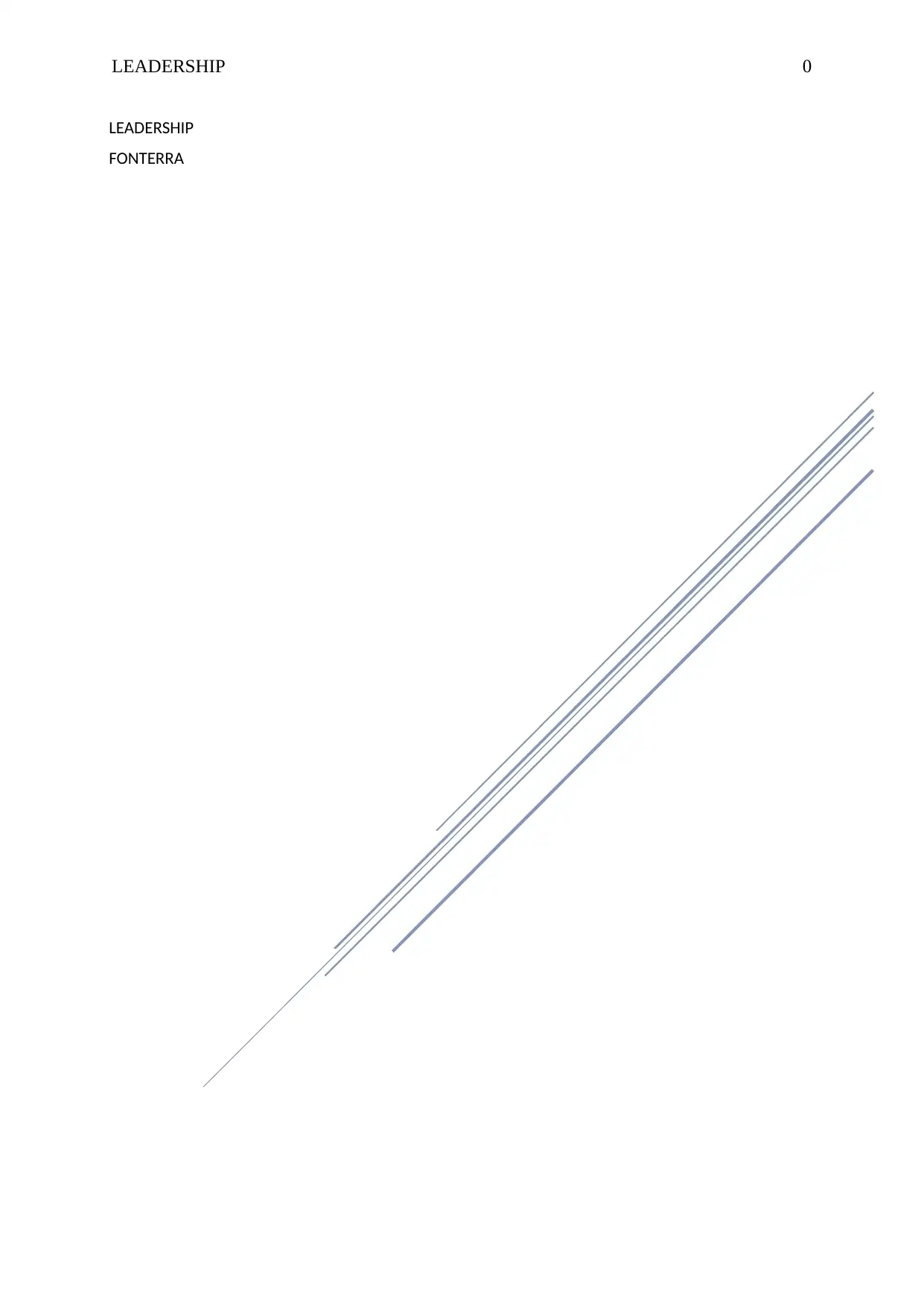
LEADERSHIP 0
LEADERSHIP
FONTERRA
LEADERSHIP
FONTERRA
Secure Best Marks with AI Grader
Need help grading? Try our AI Grader for instant feedback on your assignments.
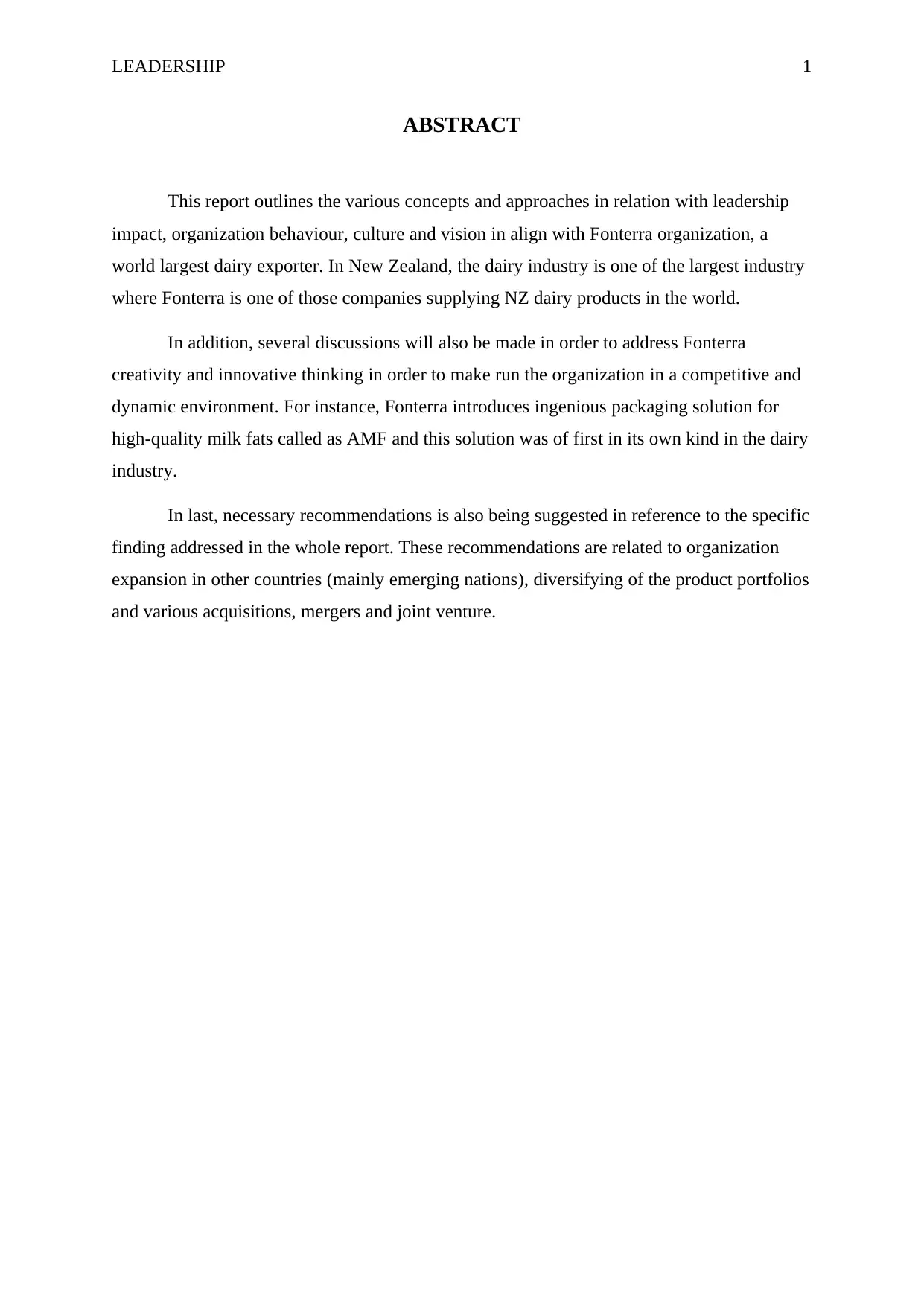
LEADERSHIP 1
ABSTRACT
This report outlines the various concepts and approaches in relation with leadership
impact, organization behaviour, culture and vision in align with Fonterra organization, a
world largest dairy exporter. In New Zealand, the dairy industry is one of the largest industry
where Fonterra is one of those companies supplying NZ dairy products in the world.
In addition, several discussions will also be made in order to address Fonterra
creativity and innovative thinking in order to make run the organization in a competitive and
dynamic environment. For instance, Fonterra introduces ingenious packaging solution for
high-quality milk fats called as AMF and this solution was of first in its own kind in the dairy
industry.
In last, necessary recommendations is also being suggested in reference to the specific
finding addressed in the whole report. These recommendations are related to organization
expansion in other countries (mainly emerging nations), diversifying of the product portfolios
and various acquisitions, mergers and joint venture.
ABSTRACT
This report outlines the various concepts and approaches in relation with leadership
impact, organization behaviour, culture and vision in align with Fonterra organization, a
world largest dairy exporter. In New Zealand, the dairy industry is one of the largest industry
where Fonterra is one of those companies supplying NZ dairy products in the world.
In addition, several discussions will also be made in order to address Fonterra
creativity and innovative thinking in order to make run the organization in a competitive and
dynamic environment. For instance, Fonterra introduces ingenious packaging solution for
high-quality milk fats called as AMF and this solution was of first in its own kind in the dairy
industry.
In last, necessary recommendations is also being suggested in reference to the specific
finding addressed in the whole report. These recommendations are related to organization
expansion in other countries (mainly emerging nations), diversifying of the product portfolios
and various acquisitions, mergers and joint venture.
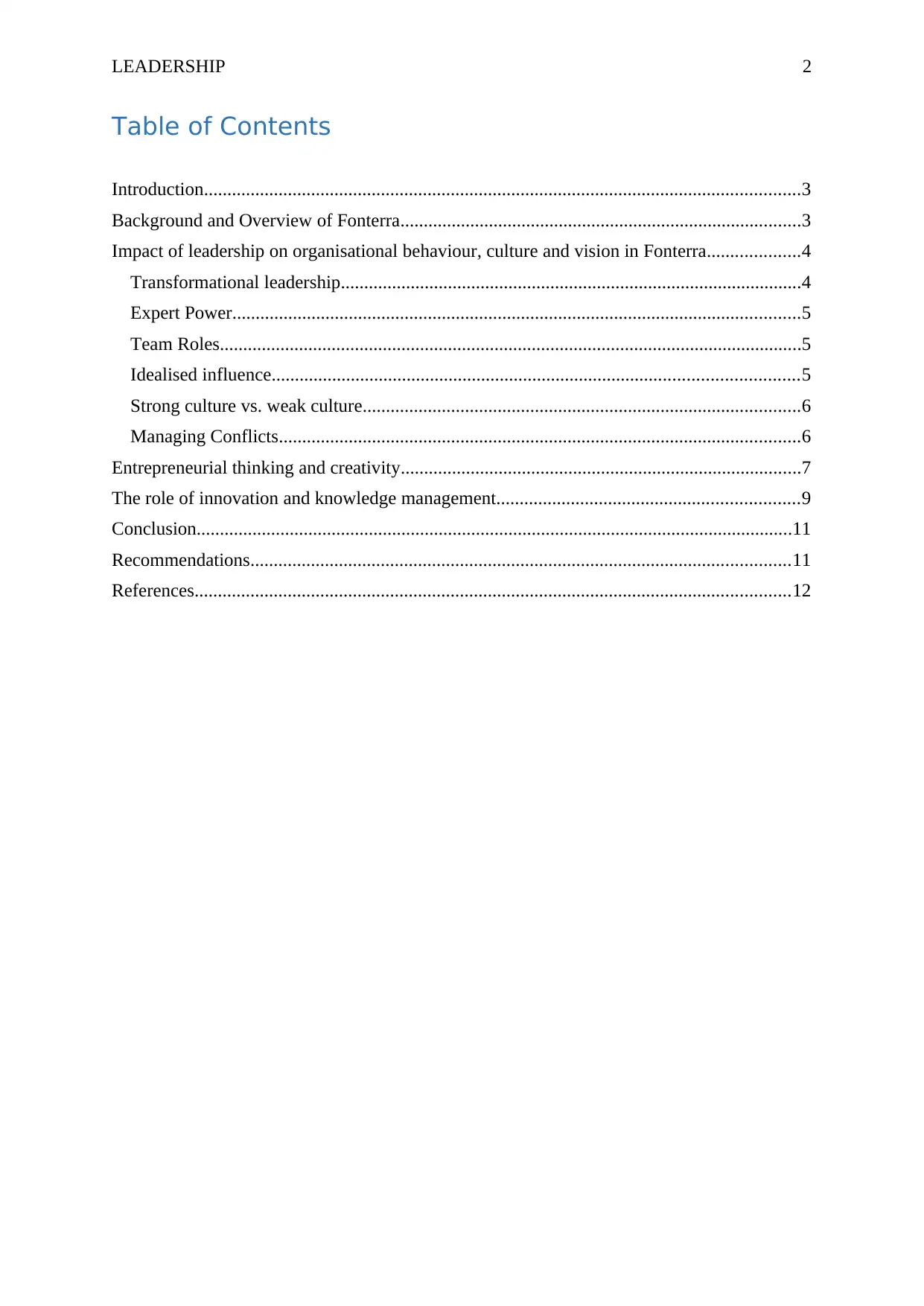
LEADERSHIP 2
Table of Contents
Introduction................................................................................................................................3
Background and Overview of Fonterra......................................................................................3
Impact of leadership on organisational behaviour, culture and vision in Fonterra....................4
Transformational leadership...................................................................................................4
Expert Power..........................................................................................................................5
Team Roles.............................................................................................................................5
Idealised influence.................................................................................................................5
Strong culture vs. weak culture..............................................................................................6
Managing Conflicts................................................................................................................6
Entrepreneurial thinking and creativity......................................................................................7
The role of innovation and knowledge management.................................................................9
Conclusion................................................................................................................................11
Recommendations....................................................................................................................11
References................................................................................................................................12
Table of Contents
Introduction................................................................................................................................3
Background and Overview of Fonterra......................................................................................3
Impact of leadership on organisational behaviour, culture and vision in Fonterra....................4
Transformational leadership...................................................................................................4
Expert Power..........................................................................................................................5
Team Roles.............................................................................................................................5
Idealised influence.................................................................................................................5
Strong culture vs. weak culture..............................................................................................6
Managing Conflicts................................................................................................................6
Entrepreneurial thinking and creativity......................................................................................7
The role of innovation and knowledge management.................................................................9
Conclusion................................................................................................................................11
Recommendations....................................................................................................................11
References................................................................................................................................12
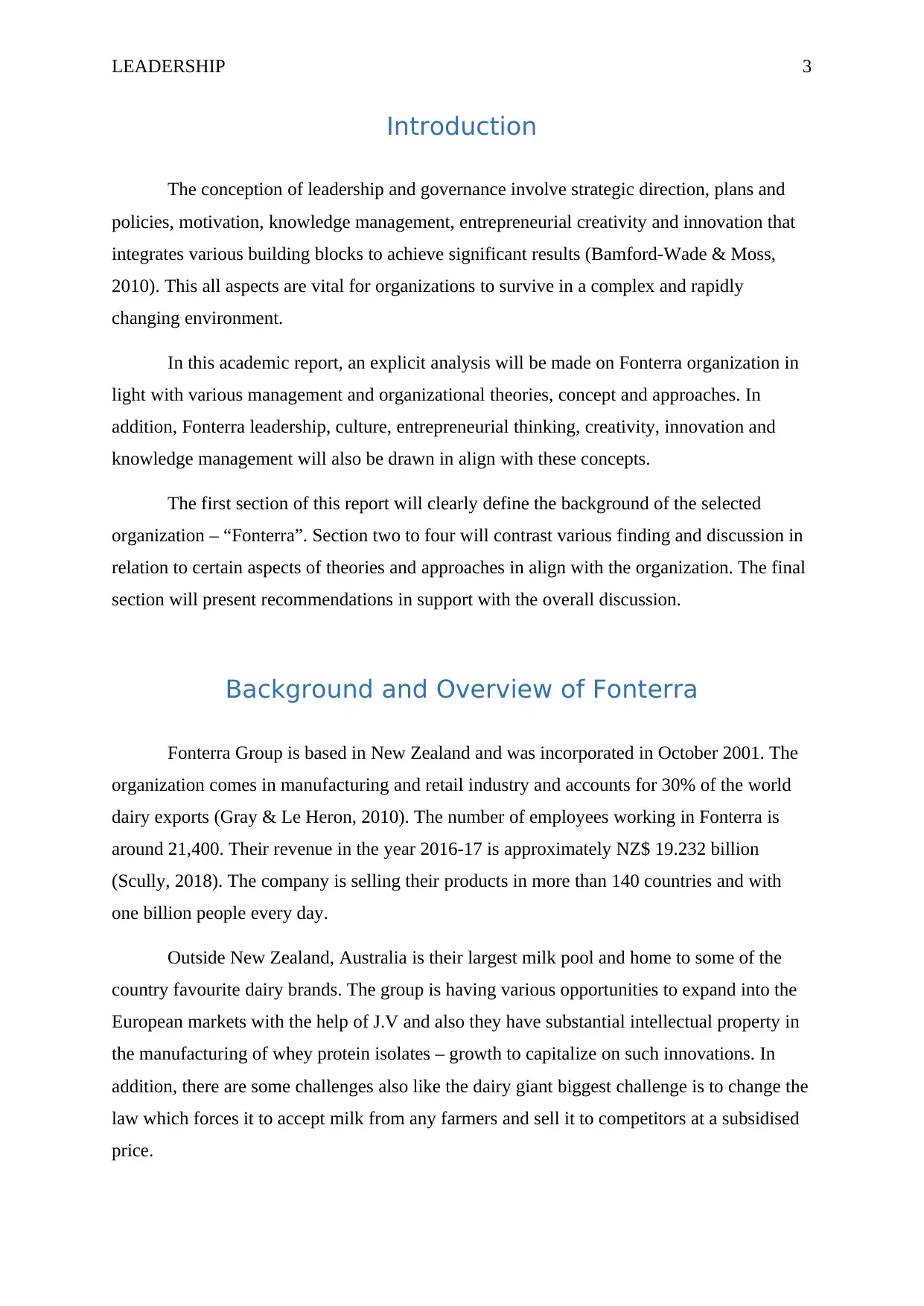
LEADERSHIP 3
Introduction
The conception of leadership and governance involve strategic direction, plans and
policies, motivation, knowledge management, entrepreneurial creativity and innovation that
integrates various building blocks to achieve significant results (Bamford-Wade & Moss,
2010). This all aspects are vital for organizations to survive in a complex and rapidly
changing environment.
In this academic report, an explicit analysis will be made on Fonterra organization in
light with various management and organizational theories, concept and approaches. In
addition, Fonterra leadership, culture, entrepreneurial thinking, creativity, innovation and
knowledge management will also be drawn in align with these concepts.
The first section of this report will clearly define the background of the selected
organization – “Fonterra”. Section two to four will contrast various finding and discussion in
relation to certain aspects of theories and approaches in align with the organization. The final
section will present recommendations in support with the overall discussion.
Background and Overview of Fonterra
Fonterra Group is based in New Zealand and was incorporated in October 2001. The
organization comes in manufacturing and retail industry and accounts for 30% of the world
dairy exports (Gray & Le Heron, 2010). The number of employees working in Fonterra is
around 21,400. Their revenue in the year 2016-17 is approximately NZ$ 19.232 billion
(Scully, 2018). The company is selling their products in more than 140 countries and with
one billion people every day.
Outside New Zealand, Australia is their largest milk pool and home to some of the
country favourite dairy brands. The group is having various opportunities to expand into the
European markets with the help of J.V and also they have substantial intellectual property in
the manufacturing of whey protein isolates – growth to capitalize on such innovations. In
addition, there are some challenges also like the dairy giant biggest challenge is to change the
law which forces it to accept milk from any farmers and sell it to competitors at a subsidised
price.
Introduction
The conception of leadership and governance involve strategic direction, plans and
policies, motivation, knowledge management, entrepreneurial creativity and innovation that
integrates various building blocks to achieve significant results (Bamford-Wade & Moss,
2010). This all aspects are vital for organizations to survive in a complex and rapidly
changing environment.
In this academic report, an explicit analysis will be made on Fonterra organization in
light with various management and organizational theories, concept and approaches. In
addition, Fonterra leadership, culture, entrepreneurial thinking, creativity, innovation and
knowledge management will also be drawn in align with these concepts.
The first section of this report will clearly define the background of the selected
organization – “Fonterra”. Section two to four will contrast various finding and discussion in
relation to certain aspects of theories and approaches in align with the organization. The final
section will present recommendations in support with the overall discussion.
Background and Overview of Fonterra
Fonterra Group is based in New Zealand and was incorporated in October 2001. The
organization comes in manufacturing and retail industry and accounts for 30% of the world
dairy exports (Gray & Le Heron, 2010). The number of employees working in Fonterra is
around 21,400. Their revenue in the year 2016-17 is approximately NZ$ 19.232 billion
(Scully, 2018). The company is selling their products in more than 140 countries and with
one billion people every day.
Outside New Zealand, Australia is their largest milk pool and home to some of the
country favourite dairy brands. The group is having various opportunities to expand into the
European markets with the help of J.V and also they have substantial intellectual property in
the manufacturing of whey protein isolates – growth to capitalize on such innovations. In
addition, there are some challenges also like the dairy giant biggest challenge is to change the
law which forces it to accept milk from any farmers and sell it to competitors at a subsidised
price.
Secure Best Marks with AI Grader
Need help grading? Try our AI Grader for instant feedback on your assignments.
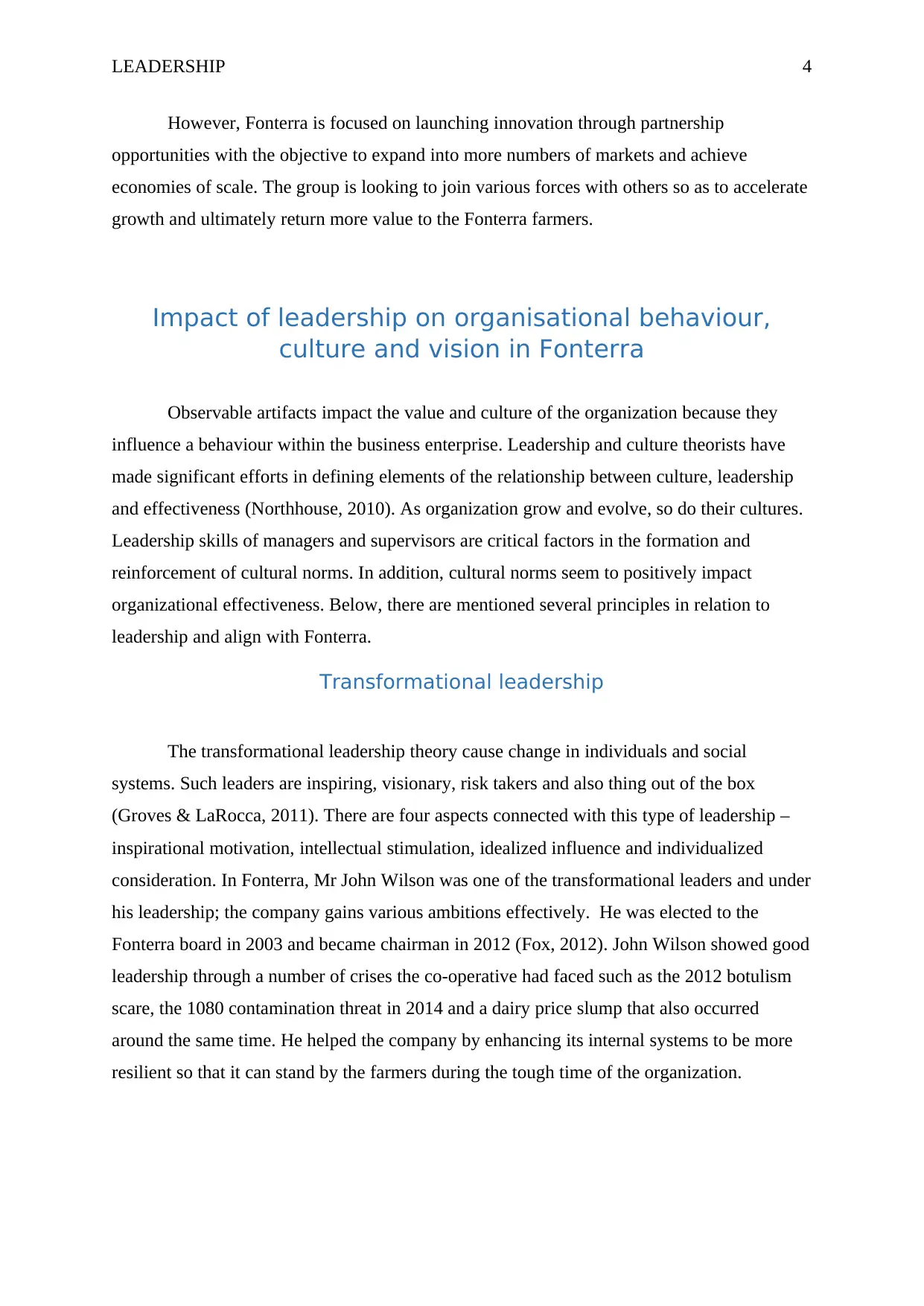
LEADERSHIP 4
However, Fonterra is focused on launching innovation through partnership
opportunities with the objective to expand into more numbers of markets and achieve
economies of scale. The group is looking to join various forces with others so as to accelerate
growth and ultimately return more value to the Fonterra farmers.
Impact of leadership on organisational behaviour,
culture and vision in Fonterra
Observable artifacts impact the value and culture of the organization because they
influence a behaviour within the business enterprise. Leadership and culture theorists have
made significant efforts in defining elements of the relationship between culture, leadership
and effectiveness (Northhouse, 2010). As organization grow and evolve, so do their cultures.
Leadership skills of managers and supervisors are critical factors in the formation and
reinforcement of cultural norms. In addition, cultural norms seem to positively impact
organizational effectiveness. Below, there are mentioned several principles in relation to
leadership and align with Fonterra.
Transformational leadership
The transformational leadership theory cause change in individuals and social
systems. Such leaders are inspiring, visionary, risk takers and also thing out of the box
(Groves & LaRocca, 2011). There are four aspects connected with this type of leadership –
inspirational motivation, intellectual stimulation, idealized influence and individualized
consideration. In Fonterra, Mr John Wilson was one of the transformational leaders and under
his leadership; the company gains various ambitions effectively. He was elected to the
Fonterra board in 2003 and became chairman in 2012 (Fox, 2012). John Wilson showed good
leadership through a number of crises the co-operative had faced such as the 2012 botulism
scare, the 1080 contamination threat in 2014 and a dairy price slump that also occurred
around the same time. He helped the company by enhancing its internal systems to be more
resilient so that it can stand by the farmers during the tough time of the organization.
However, Fonterra is focused on launching innovation through partnership
opportunities with the objective to expand into more numbers of markets and achieve
economies of scale. The group is looking to join various forces with others so as to accelerate
growth and ultimately return more value to the Fonterra farmers.
Impact of leadership on organisational behaviour,
culture and vision in Fonterra
Observable artifacts impact the value and culture of the organization because they
influence a behaviour within the business enterprise. Leadership and culture theorists have
made significant efforts in defining elements of the relationship between culture, leadership
and effectiveness (Northhouse, 2010). As organization grow and evolve, so do their cultures.
Leadership skills of managers and supervisors are critical factors in the formation and
reinforcement of cultural norms. In addition, cultural norms seem to positively impact
organizational effectiveness. Below, there are mentioned several principles in relation to
leadership and align with Fonterra.
Transformational leadership
The transformational leadership theory cause change in individuals and social
systems. Such leaders are inspiring, visionary, risk takers and also thing out of the box
(Groves & LaRocca, 2011). There are four aspects connected with this type of leadership –
inspirational motivation, intellectual stimulation, idealized influence and individualized
consideration. In Fonterra, Mr John Wilson was one of the transformational leaders and under
his leadership; the company gains various ambitions effectively. He was elected to the
Fonterra board in 2003 and became chairman in 2012 (Fox, 2012). John Wilson showed good
leadership through a number of crises the co-operative had faced such as the 2012 botulism
scare, the 1080 contamination threat in 2014 and a dairy price slump that also occurred
around the same time. He helped the company by enhancing its internal systems to be more
resilient so that it can stand by the farmers during the tough time of the organization.
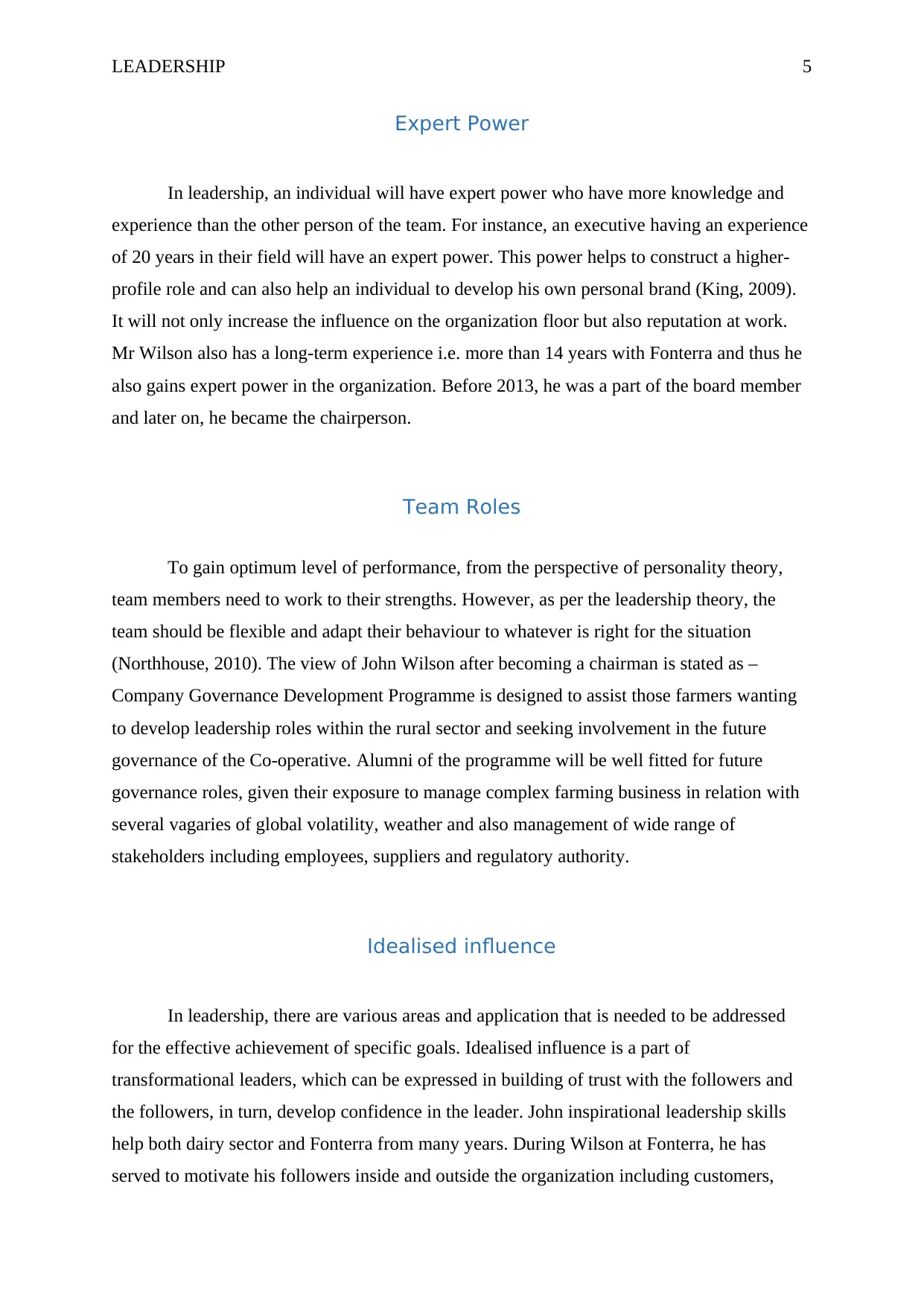
LEADERSHIP 5
Expert Power
In leadership, an individual will have expert power who have more knowledge and
experience than the other person of the team. For instance, an executive having an experience
of 20 years in their field will have an expert power. This power helps to construct a higher-
profile role and can also help an individual to develop his own personal brand (King, 2009).
It will not only increase the influence on the organization floor but also reputation at work.
Mr Wilson also has a long-term experience i.e. more than 14 years with Fonterra and thus he
also gains expert power in the organization. Before 2013, he was a part of the board member
and later on, he became the chairperson.
Team Roles
To gain optimum level of performance, from the perspective of personality theory,
team members need to work to their strengths. However, as per the leadership theory, the
team should be flexible and adapt their behaviour to whatever is right for the situation
(Northhouse, 2010). The view of John Wilson after becoming a chairman is stated as –
Company Governance Development Programme is designed to assist those farmers wanting
to develop leadership roles within the rural sector and seeking involvement in the future
governance of the Co-operative. Alumni of the programme will be well fitted for future
governance roles, given their exposure to manage complex farming business in relation with
several vagaries of global volatility, weather and also management of wide range of
stakeholders including employees, suppliers and regulatory authority.
Idealised influence
In leadership, there are various areas and application that is needed to be addressed
for the effective achievement of specific goals. Idealised influence is a part of
transformational leaders, which can be expressed in building of trust with the followers and
the followers, in turn, develop confidence in the leader. John inspirational leadership skills
help both dairy sector and Fonterra from many years. During Wilson at Fonterra, he has
served to motivate his followers inside and outside the organization including customers,
Expert Power
In leadership, an individual will have expert power who have more knowledge and
experience than the other person of the team. For instance, an executive having an experience
of 20 years in their field will have an expert power. This power helps to construct a higher-
profile role and can also help an individual to develop his own personal brand (King, 2009).
It will not only increase the influence on the organization floor but also reputation at work.
Mr Wilson also has a long-term experience i.e. more than 14 years with Fonterra and thus he
also gains expert power in the organization. Before 2013, he was a part of the board member
and later on, he became the chairperson.
Team Roles
To gain optimum level of performance, from the perspective of personality theory,
team members need to work to their strengths. However, as per the leadership theory, the
team should be flexible and adapt their behaviour to whatever is right for the situation
(Northhouse, 2010). The view of John Wilson after becoming a chairman is stated as –
Company Governance Development Programme is designed to assist those farmers wanting
to develop leadership roles within the rural sector and seeking involvement in the future
governance of the Co-operative. Alumni of the programme will be well fitted for future
governance roles, given their exposure to manage complex farming business in relation with
several vagaries of global volatility, weather and also management of wide range of
stakeholders including employees, suppliers and regulatory authority.
Idealised influence
In leadership, there are various areas and application that is needed to be addressed
for the effective achievement of specific goals. Idealised influence is a part of
transformational leaders, which can be expressed in building of trust with the followers and
the followers, in turn, develop confidence in the leader. John inspirational leadership skills
help both dairy sector and Fonterra from many years. During Wilson at Fonterra, he has
served to motivate his followers inside and outside the organization including customers,
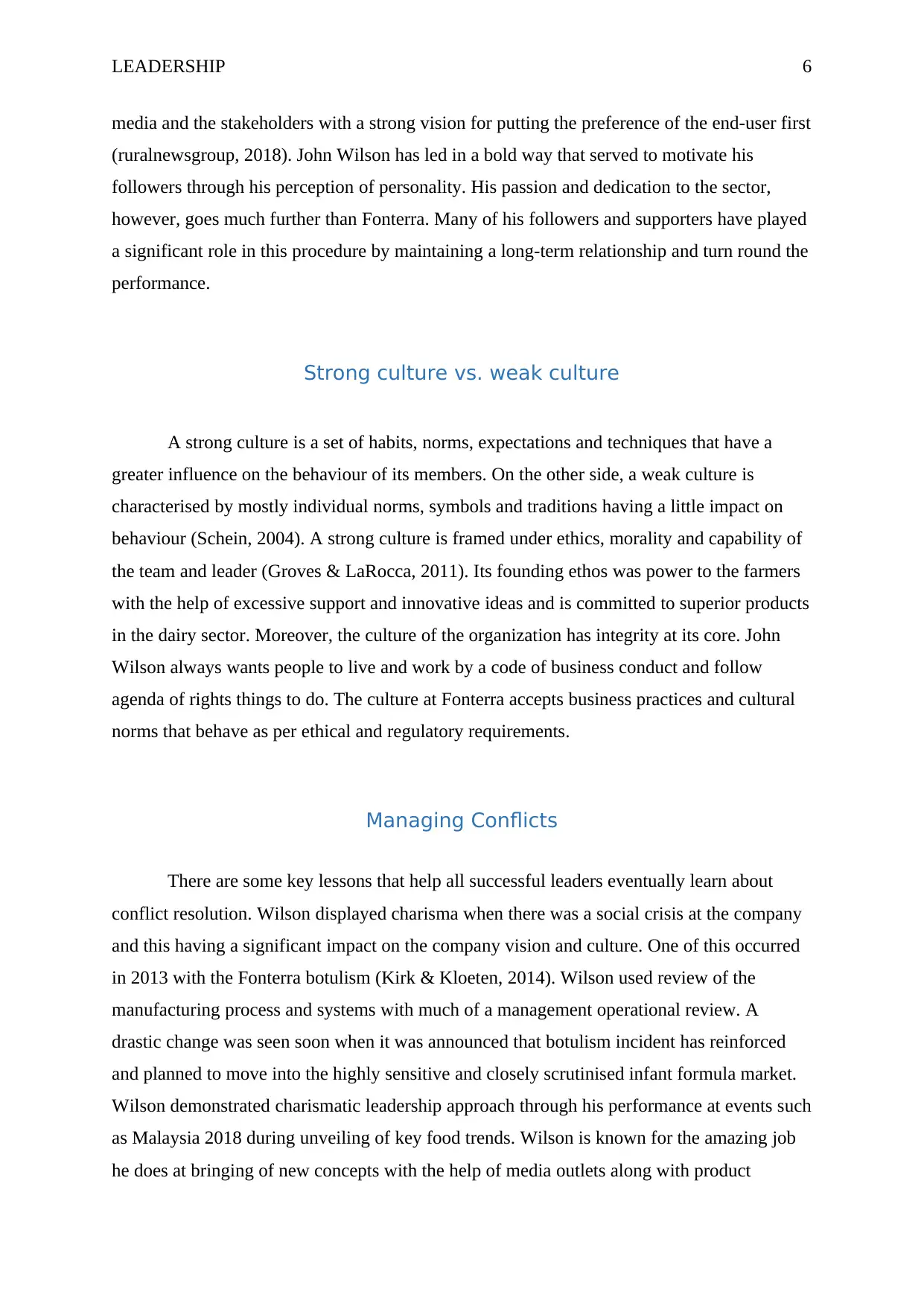
LEADERSHIP 6
media and the stakeholders with a strong vision for putting the preference of the end-user first
(ruralnewsgroup, 2018). John Wilson has led in a bold way that served to motivate his
followers through his perception of personality. His passion and dedication to the sector,
however, goes much further than Fonterra. Many of his followers and supporters have played
a significant role in this procedure by maintaining a long-term relationship and turn round the
performance.
Strong culture vs. weak culture
A strong culture is a set of habits, norms, expectations and techniques that have a
greater influence on the behaviour of its members. On the other side, a weak culture is
characterised by mostly individual norms, symbols and traditions having a little impact on
behaviour (Schein, 2004). A strong culture is framed under ethics, morality and capability of
the team and leader (Groves & LaRocca, 2011). Its founding ethos was power to the farmers
with the help of excessive support and innovative ideas and is committed to superior products
in the dairy sector. Moreover, the culture of the organization has integrity at its core. John
Wilson always wants people to live and work by a code of business conduct and follow
agenda of rights things to do. The culture at Fonterra accepts business practices and cultural
norms that behave as per ethical and regulatory requirements.
Managing Conflicts
There are some key lessons that help all successful leaders eventually learn about
conflict resolution. Wilson displayed charisma when there was a social crisis at the company
and this having a significant impact on the company vision and culture. One of this occurred
in 2013 with the Fonterra botulism (Kirk & Kloeten, 2014). Wilson used review of the
manufacturing process and systems with much of a management operational review. A
drastic change was seen soon when it was announced that botulism incident has reinforced
and planned to move into the highly sensitive and closely scrutinised infant formula market.
Wilson demonstrated charismatic leadership approach through his performance at events such
as Malaysia 2018 during unveiling of key food trends. Wilson is known for the amazing job
he does at bringing of new concepts with the help of media outlets along with product
media and the stakeholders with a strong vision for putting the preference of the end-user first
(ruralnewsgroup, 2018). John Wilson has led in a bold way that served to motivate his
followers through his perception of personality. His passion and dedication to the sector,
however, goes much further than Fonterra. Many of his followers and supporters have played
a significant role in this procedure by maintaining a long-term relationship and turn round the
performance.
Strong culture vs. weak culture
A strong culture is a set of habits, norms, expectations and techniques that have a
greater influence on the behaviour of its members. On the other side, a weak culture is
characterised by mostly individual norms, symbols and traditions having a little impact on
behaviour (Schein, 2004). A strong culture is framed under ethics, morality and capability of
the team and leader (Groves & LaRocca, 2011). Its founding ethos was power to the farmers
with the help of excessive support and innovative ideas and is committed to superior products
in the dairy sector. Moreover, the culture of the organization has integrity at its core. John
Wilson always wants people to live and work by a code of business conduct and follow
agenda of rights things to do. The culture at Fonterra accepts business practices and cultural
norms that behave as per ethical and regulatory requirements.
Managing Conflicts
There are some key lessons that help all successful leaders eventually learn about
conflict resolution. Wilson displayed charisma when there was a social crisis at the company
and this having a significant impact on the company vision and culture. One of this occurred
in 2013 with the Fonterra botulism (Kirk & Kloeten, 2014). Wilson used review of the
manufacturing process and systems with much of a management operational review. A
drastic change was seen soon when it was announced that botulism incident has reinforced
and planned to move into the highly sensitive and closely scrutinised infant formula market.
Wilson demonstrated charismatic leadership approach through his performance at events such
as Malaysia 2018 during unveiling of key food trends. Wilson is known for the amazing job
he does at bringing of new concepts with the help of media outlets along with product
Paraphrase This Document
Need a fresh take? Get an instant paraphrase of this document with our AI Paraphraser
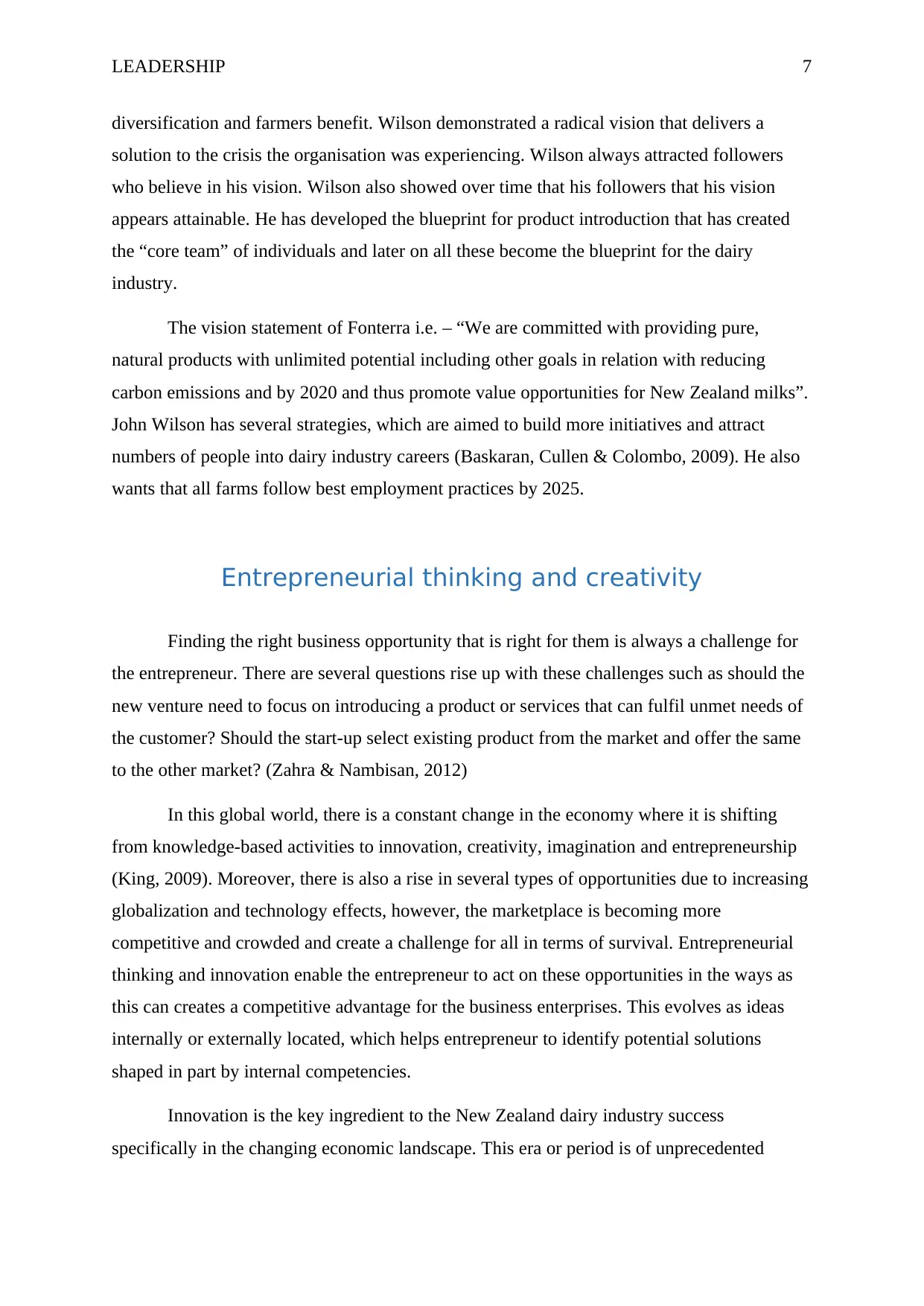
LEADERSHIP 7
diversification and farmers benefit. Wilson demonstrated a radical vision that delivers a
solution to the crisis the organisation was experiencing. Wilson always attracted followers
who believe in his vision. Wilson also showed over time that his followers that his vision
appears attainable. He has developed the blueprint for product introduction that has created
the “core team” of individuals and later on all these become the blueprint for the dairy
industry.
The vision statement of Fonterra i.e. – “We are committed with providing pure,
natural products with unlimited potential including other goals in relation with reducing
carbon emissions and by 2020 and thus promote value opportunities for New Zealand milks”.
John Wilson has several strategies, which are aimed to build more initiatives and attract
numbers of people into dairy industry careers (Baskaran, Cullen & Colombo, 2009). He also
wants that all farms follow best employment practices by 2025.
Entrepreneurial thinking and creativity
Finding the right business opportunity that is right for them is always a challenge for
the entrepreneur. There are several questions rise up with these challenges such as should the
new venture need to focus on introducing a product or services that can fulfil unmet needs of
the customer? Should the start-up select existing product from the market and offer the same
to the other market? (Zahra & Nambisan, 2012)
In this global world, there is a constant change in the economy where it is shifting
from knowledge-based activities to innovation, creativity, imagination and entrepreneurship
(King, 2009). Moreover, there is also a rise in several types of opportunities due to increasing
globalization and technology effects, however, the marketplace is becoming more
competitive and crowded and create a challenge for all in terms of survival. Entrepreneurial
thinking and innovation enable the entrepreneur to act on these opportunities in the ways as
this can creates a competitive advantage for the business enterprises. This evolves as ideas
internally or externally located, which helps entrepreneur to identify potential solutions
shaped in part by internal competencies.
Innovation is the key ingredient to the New Zealand dairy industry success
specifically in the changing economic landscape. This era or period is of unprecedented
diversification and farmers benefit. Wilson demonstrated a radical vision that delivers a
solution to the crisis the organisation was experiencing. Wilson always attracted followers
who believe in his vision. Wilson also showed over time that his followers that his vision
appears attainable. He has developed the blueprint for product introduction that has created
the “core team” of individuals and later on all these become the blueprint for the dairy
industry.
The vision statement of Fonterra i.e. – “We are committed with providing pure,
natural products with unlimited potential including other goals in relation with reducing
carbon emissions and by 2020 and thus promote value opportunities for New Zealand milks”.
John Wilson has several strategies, which are aimed to build more initiatives and attract
numbers of people into dairy industry careers (Baskaran, Cullen & Colombo, 2009). He also
wants that all farms follow best employment practices by 2025.
Entrepreneurial thinking and creativity
Finding the right business opportunity that is right for them is always a challenge for
the entrepreneur. There are several questions rise up with these challenges such as should the
new venture need to focus on introducing a product or services that can fulfil unmet needs of
the customer? Should the start-up select existing product from the market and offer the same
to the other market? (Zahra & Nambisan, 2012)
In this global world, there is a constant change in the economy where it is shifting
from knowledge-based activities to innovation, creativity, imagination and entrepreneurship
(King, 2009). Moreover, there is also a rise in several types of opportunities due to increasing
globalization and technology effects, however, the marketplace is becoming more
competitive and crowded and create a challenge for all in terms of survival. Entrepreneurial
thinking and innovation enable the entrepreneur to act on these opportunities in the ways as
this can creates a competitive advantage for the business enterprises. This evolves as ideas
internally or externally located, which helps entrepreneur to identify potential solutions
shaped in part by internal competencies.
Innovation is the key ingredient to the New Zealand dairy industry success
specifically in the changing economic landscape. This era or period is of unprecedented
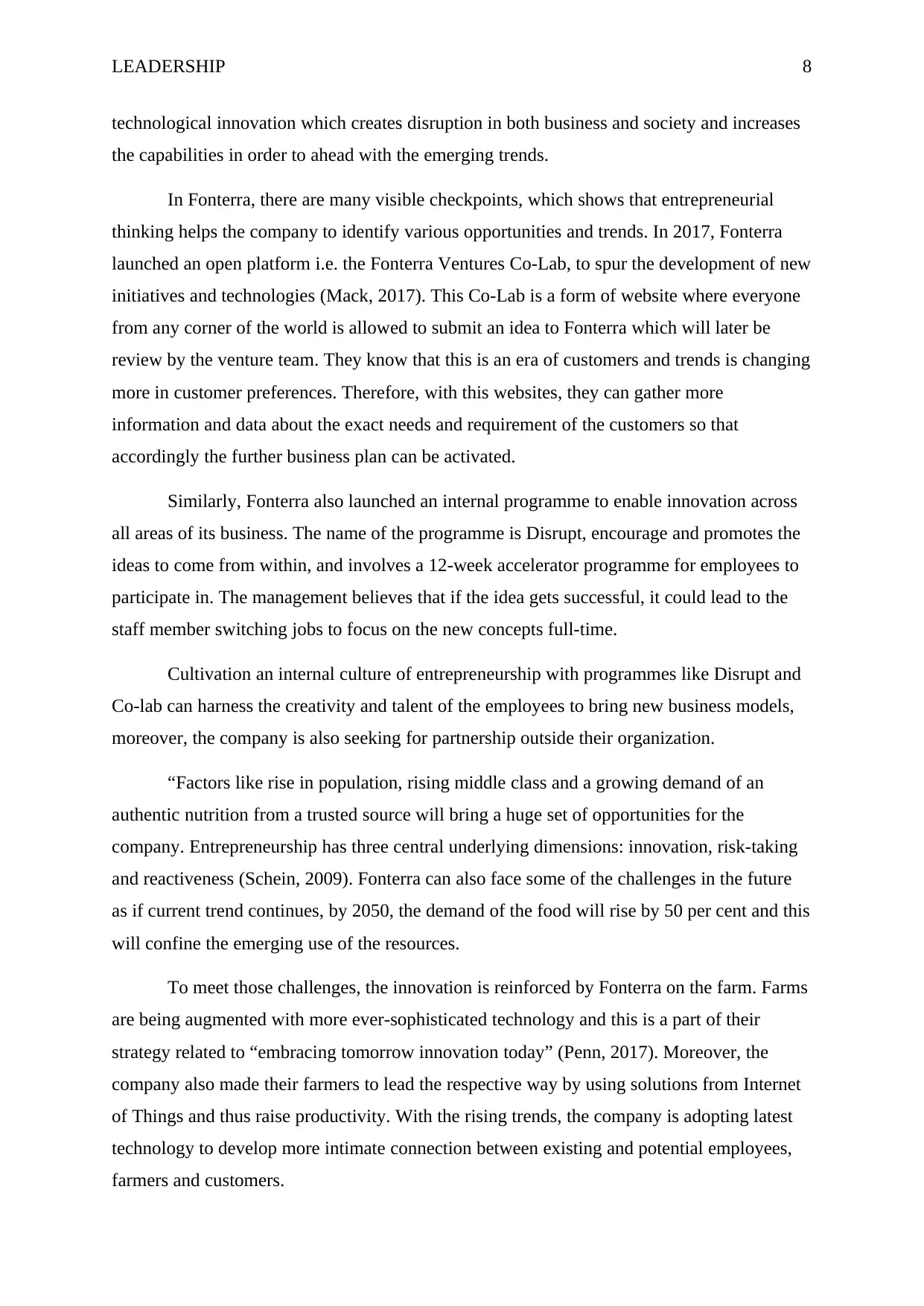
LEADERSHIP 8
technological innovation which creates disruption in both business and society and increases
the capabilities in order to ahead with the emerging trends.
In Fonterra, there are many visible checkpoints, which shows that entrepreneurial
thinking helps the company to identify various opportunities and trends. In 2017, Fonterra
launched an open platform i.e. the Fonterra Ventures Co-Lab, to spur the development of new
initiatives and technologies (Mack, 2017). This Co-Lab is a form of website where everyone
from any corner of the world is allowed to submit an idea to Fonterra which will later be
review by the venture team. They know that this is an era of customers and trends is changing
more in customer preferences. Therefore, with this websites, they can gather more
information and data about the exact needs and requirement of the customers so that
accordingly the further business plan can be activated.
Similarly, Fonterra also launched an internal programme to enable innovation across
all areas of its business. The name of the programme is Disrupt, encourage and promotes the
ideas to come from within, and involves a 12-week accelerator programme for employees to
participate in. The management believes that if the idea gets successful, it could lead to the
staff member switching jobs to focus on the new concepts full-time.
Cultivation an internal culture of entrepreneurship with programmes like Disrupt and
Co-lab can harness the creativity and talent of the employees to bring new business models,
moreover, the company is also seeking for partnership outside their organization.
“Factors like rise in population, rising middle class and a growing demand of an
authentic nutrition from a trusted source will bring a huge set of opportunities for the
company. Entrepreneurship has three central underlying dimensions: innovation, risk-taking
and reactiveness (Schein, 2009). Fonterra can also face some of the challenges in the future
as if current trend continues, by 2050, the demand of the food will rise by 50 per cent and this
will confine the emerging use of the resources.
To meet those challenges, the innovation is reinforced by Fonterra on the farm. Farms
are being augmented with more ever-sophisticated technology and this is a part of their
strategy related to “embracing tomorrow innovation today” (Penn, 2017). Moreover, the
company also made their farmers to lead the respective way by using solutions from Internet
of Things and thus raise productivity. With the rising trends, the company is adopting latest
technology to develop more intimate connection between existing and potential employees,
farmers and customers.
technological innovation which creates disruption in both business and society and increases
the capabilities in order to ahead with the emerging trends.
In Fonterra, there are many visible checkpoints, which shows that entrepreneurial
thinking helps the company to identify various opportunities and trends. In 2017, Fonterra
launched an open platform i.e. the Fonterra Ventures Co-Lab, to spur the development of new
initiatives and technologies (Mack, 2017). This Co-Lab is a form of website where everyone
from any corner of the world is allowed to submit an idea to Fonterra which will later be
review by the venture team. They know that this is an era of customers and trends is changing
more in customer preferences. Therefore, with this websites, they can gather more
information and data about the exact needs and requirement of the customers so that
accordingly the further business plan can be activated.
Similarly, Fonterra also launched an internal programme to enable innovation across
all areas of its business. The name of the programme is Disrupt, encourage and promotes the
ideas to come from within, and involves a 12-week accelerator programme for employees to
participate in. The management believes that if the idea gets successful, it could lead to the
staff member switching jobs to focus on the new concepts full-time.
Cultivation an internal culture of entrepreneurship with programmes like Disrupt and
Co-lab can harness the creativity and talent of the employees to bring new business models,
moreover, the company is also seeking for partnership outside their organization.
“Factors like rise in population, rising middle class and a growing demand of an
authentic nutrition from a trusted source will bring a huge set of opportunities for the
company. Entrepreneurship has three central underlying dimensions: innovation, risk-taking
and reactiveness (Schein, 2009). Fonterra can also face some of the challenges in the future
as if current trend continues, by 2050, the demand of the food will rise by 50 per cent and this
will confine the emerging use of the resources.
To meet those challenges, the innovation is reinforced by Fonterra on the farm. Farms
are being augmented with more ever-sophisticated technology and this is a part of their
strategy related to “embracing tomorrow innovation today” (Penn, 2017). Moreover, the
company also made their farmers to lead the respective way by using solutions from Internet
of Things and thus raise productivity. With the rising trends, the company is adopting latest
technology to develop more intimate connection between existing and potential employees,
farmers and customers.

LEADERSHIP 9
Moreover, if the internal culture will be translated into product innovation, the
benefits can easily be observed on a global level (Schein, 2004). Fonterra already serves more
than 1 billion consumers internationally in over 140 countries and as per their ambition, they
want to make a difference in the lives of two billion people by 2025.
It is ascertained that creativity is potentially more useful from overcoming barriers in
acquiring the resources and also deriving alternative and lower cost solution for the purpose
of solving problems. Understanding entrepreneurship and creativity by the Fonterra leverage
them with lower cost as well as necessary solutions that are important to future economic
success. However, future research needs to be embraced with more innovative and creative
opportunities so that the organization can be effectively fit into the rising trends and
opportunities and gain competitive edge in the dairy industry all over the countries.
The role of innovation and knowledge management
Organization success, attraction and the place in the market depend very much on its
chosen strategy and implementation, which are inseparable from the process of information
data system and knowledge expansion (Teece, 2010). This 21st Century and the globalised
economy requires strategies framed with the concepts of knowledge management under the
various conditions of competitiveness and innovation. Managing knowledge is an important
leadership role because very few organizations make systematic use of the collective wisdom
of employees (King, 2009).
As per Fonterra, delivering safe, sustainable nutrition is one of the significant global
issues and to solve this issue, Daily nutrition is very important. With their extensive research
and development, they are able to make superior dairy nutrition accessible to vast locations
and more numbers of people, helping to improve health at key life stages.
Fonterra Research and Development Centre is situated in Palmerston, New Zealand.
This has employed various world-leading experts around the globe in dairy research and
development. They are innovating with developing several specialised ingredients that can
help in reducing the risk of allergies a boosted immunity. They are also harnessing new
technologies and collaborating by forming trusted partnership, as they believe innovation
Moreover, if the internal culture will be translated into product innovation, the
benefits can easily be observed on a global level (Schein, 2004). Fonterra already serves more
than 1 billion consumers internationally in over 140 countries and as per their ambition, they
want to make a difference in the lives of two billion people by 2025.
It is ascertained that creativity is potentially more useful from overcoming barriers in
acquiring the resources and also deriving alternative and lower cost solution for the purpose
of solving problems. Understanding entrepreneurship and creativity by the Fonterra leverage
them with lower cost as well as necessary solutions that are important to future economic
success. However, future research needs to be embraced with more innovative and creative
opportunities so that the organization can be effectively fit into the rising trends and
opportunities and gain competitive edge in the dairy industry all over the countries.
The role of innovation and knowledge management
Organization success, attraction and the place in the market depend very much on its
chosen strategy and implementation, which are inseparable from the process of information
data system and knowledge expansion (Teece, 2010). This 21st Century and the globalised
economy requires strategies framed with the concepts of knowledge management under the
various conditions of competitiveness and innovation. Managing knowledge is an important
leadership role because very few organizations make systematic use of the collective wisdom
of employees (King, 2009).
As per Fonterra, delivering safe, sustainable nutrition is one of the significant global
issues and to solve this issue, Daily nutrition is very important. With their extensive research
and development, they are able to make superior dairy nutrition accessible to vast locations
and more numbers of people, helping to improve health at key life stages.
Fonterra Research and Development Centre is situated in Palmerston, New Zealand.
This has employed various world-leading experts around the globe in dairy research and
development. They are innovating with developing several specialised ingredients that can
help in reducing the risk of allergies a boosted immunity. They are also harnessing new
technologies and collaborating by forming trusted partnership, as they believe innovation
Secure Best Marks with AI Grader
Need help grading? Try our AI Grader for instant feedback on your assignments.
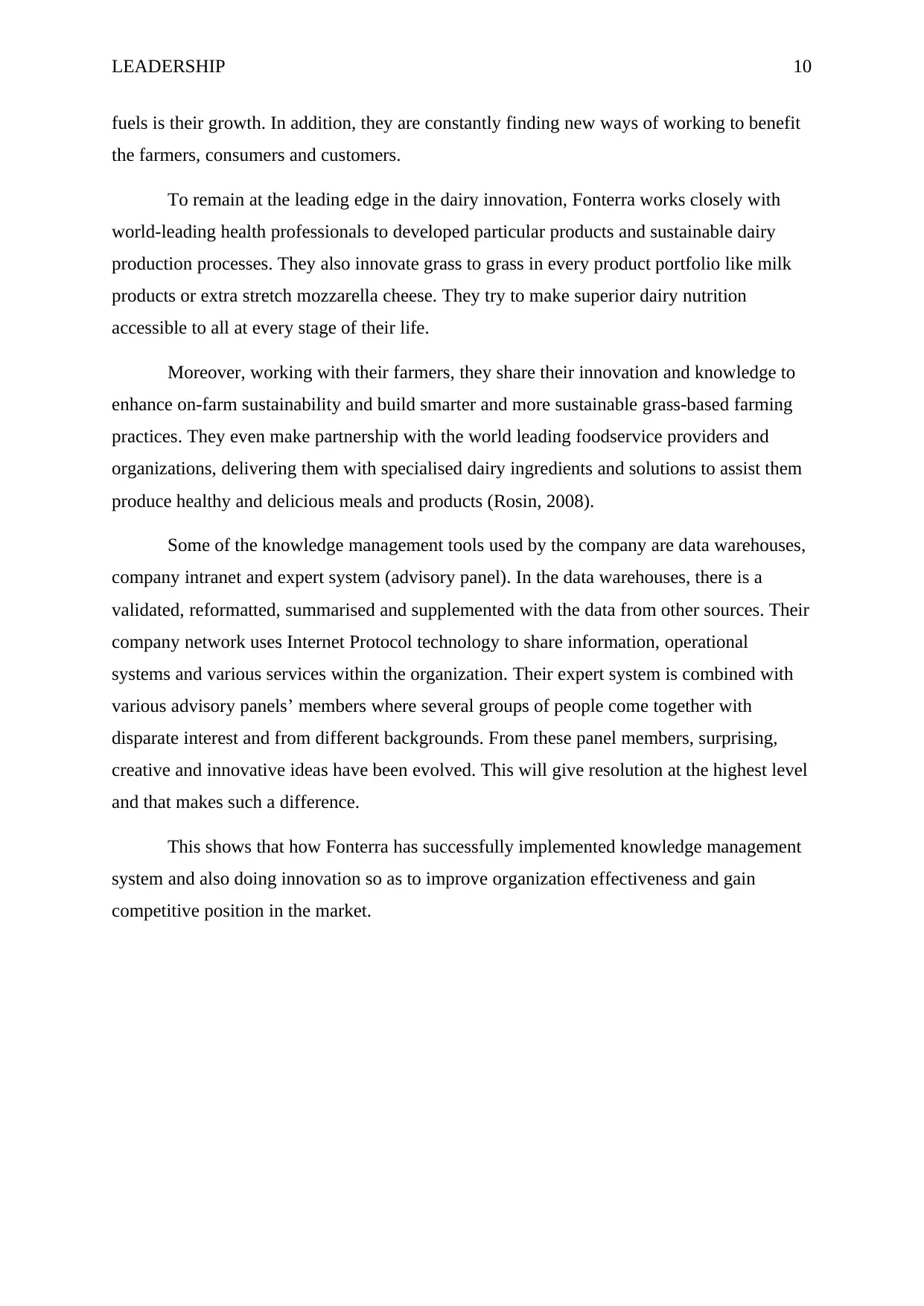
LEADERSHIP 10
fuels is their growth. In addition, they are constantly finding new ways of working to benefit
the farmers, consumers and customers.
To remain at the leading edge in the dairy innovation, Fonterra works closely with
world-leading health professionals to developed particular products and sustainable dairy
production processes. They also innovate grass to grass in every product portfolio like milk
products or extra stretch mozzarella cheese. They try to make superior dairy nutrition
accessible to all at every stage of their life.
Moreover, working with their farmers, they share their innovation and knowledge to
enhance on-farm sustainability and build smarter and more sustainable grass-based farming
practices. They even make partnership with the world leading foodservice providers and
organizations, delivering them with specialised dairy ingredients and solutions to assist them
produce healthy and delicious meals and products (Rosin, 2008).
Some of the knowledge management tools used by the company are data warehouses,
company intranet and expert system (advisory panel). In the data warehouses, there is a
validated, reformatted, summarised and supplemented with the data from other sources. Their
company network uses Internet Protocol technology to share information, operational
systems and various services within the organization. Their expert system is combined with
various advisory panels’ members where several groups of people come together with
disparate interest and from different backgrounds. From these panel members, surprising,
creative and innovative ideas have been evolved. This will give resolution at the highest level
and that makes such a difference.
This shows that how Fonterra has successfully implemented knowledge management
system and also doing innovation so as to improve organization effectiveness and gain
competitive position in the market.
fuels is their growth. In addition, they are constantly finding new ways of working to benefit
the farmers, consumers and customers.
To remain at the leading edge in the dairy innovation, Fonterra works closely with
world-leading health professionals to developed particular products and sustainable dairy
production processes. They also innovate grass to grass in every product portfolio like milk
products or extra stretch mozzarella cheese. They try to make superior dairy nutrition
accessible to all at every stage of their life.
Moreover, working with their farmers, they share their innovation and knowledge to
enhance on-farm sustainability and build smarter and more sustainable grass-based farming
practices. They even make partnership with the world leading foodservice providers and
organizations, delivering them with specialised dairy ingredients and solutions to assist them
produce healthy and delicious meals and products (Rosin, 2008).
Some of the knowledge management tools used by the company are data warehouses,
company intranet and expert system (advisory panel). In the data warehouses, there is a
validated, reformatted, summarised and supplemented with the data from other sources. Their
company network uses Internet Protocol technology to share information, operational
systems and various services within the organization. Their expert system is combined with
various advisory panels’ members where several groups of people come together with
disparate interest and from different backgrounds. From these panel members, surprising,
creative and innovative ideas have been evolved. This will give resolution at the highest level
and that makes such a difference.
This shows that how Fonterra has successfully implemented knowledge management
system and also doing innovation so as to improve organization effectiveness and gain
competitive position in the market.

LEADERSHIP 11
Conclusion
Fonterra is a famous and popular company due to their products, market share and
global presence. They also learn to innovate with the help of various crisis, failures and
accumulated experiences. The Research and Development department of Fonterra helps the
company from a long period of time in the development of various ingredients in the products
that can be useful in reducing allergies boost the immunity of any particular individual.
However, there are certain competitors that can be a bottleneck for Fonterra such as
Arla, Saputo and Amul. This makes Fonterra develop entrepreneurial and innovative thinking
so as to achieve a competitive edge in the market. Their farmers also play an important role
and it is the responsibility of the management to motivate these farmers into the company’s
vision.
Recommendations
Fonterra group is one of the largest dairy exporters in the world and hold 30% of
world dairy exports. The company is doing well in all areas and fields, however, some
necessary recommendation needs to be suggested which will prove to be an add-on to their
vision, corporate culture and innovative thinking.
Fonterra needs to expand their market in various developing or emerging countries as
his will help them to save lot of costs as well as help in achieving economy of scale. They
also need to focus on keeping themselves far from crises, media statements and losses. For
instance, they have faced a huge loss in the markets of China in some of the previous years.
Moreover, they also need to encourage more farmers to come into dairy industries, which will
be beneficial for both i.e. farmers and the organization. In this way, this will help them in
raising their productivity and profitability on a global scale.
Conclusion
Fonterra is a famous and popular company due to their products, market share and
global presence. They also learn to innovate with the help of various crisis, failures and
accumulated experiences. The Research and Development department of Fonterra helps the
company from a long period of time in the development of various ingredients in the products
that can be useful in reducing allergies boost the immunity of any particular individual.
However, there are certain competitors that can be a bottleneck for Fonterra such as
Arla, Saputo and Amul. This makes Fonterra develop entrepreneurial and innovative thinking
so as to achieve a competitive edge in the market. Their farmers also play an important role
and it is the responsibility of the management to motivate these farmers into the company’s
vision.
Recommendations
Fonterra group is one of the largest dairy exporters in the world and hold 30% of
world dairy exports. The company is doing well in all areas and fields, however, some
necessary recommendation needs to be suggested which will prove to be an add-on to their
vision, corporate culture and innovative thinking.
Fonterra needs to expand their market in various developing or emerging countries as
his will help them to save lot of costs as well as help in achieving economy of scale. They
also need to focus on keeping themselves far from crises, media statements and losses. For
instance, they have faced a huge loss in the markets of China in some of the previous years.
Moreover, they also need to encourage more farmers to come into dairy industries, which will
be beneficial for both i.e. farmers and the organization. In this way, this will help them in
raising their productivity and profitability on a global scale.
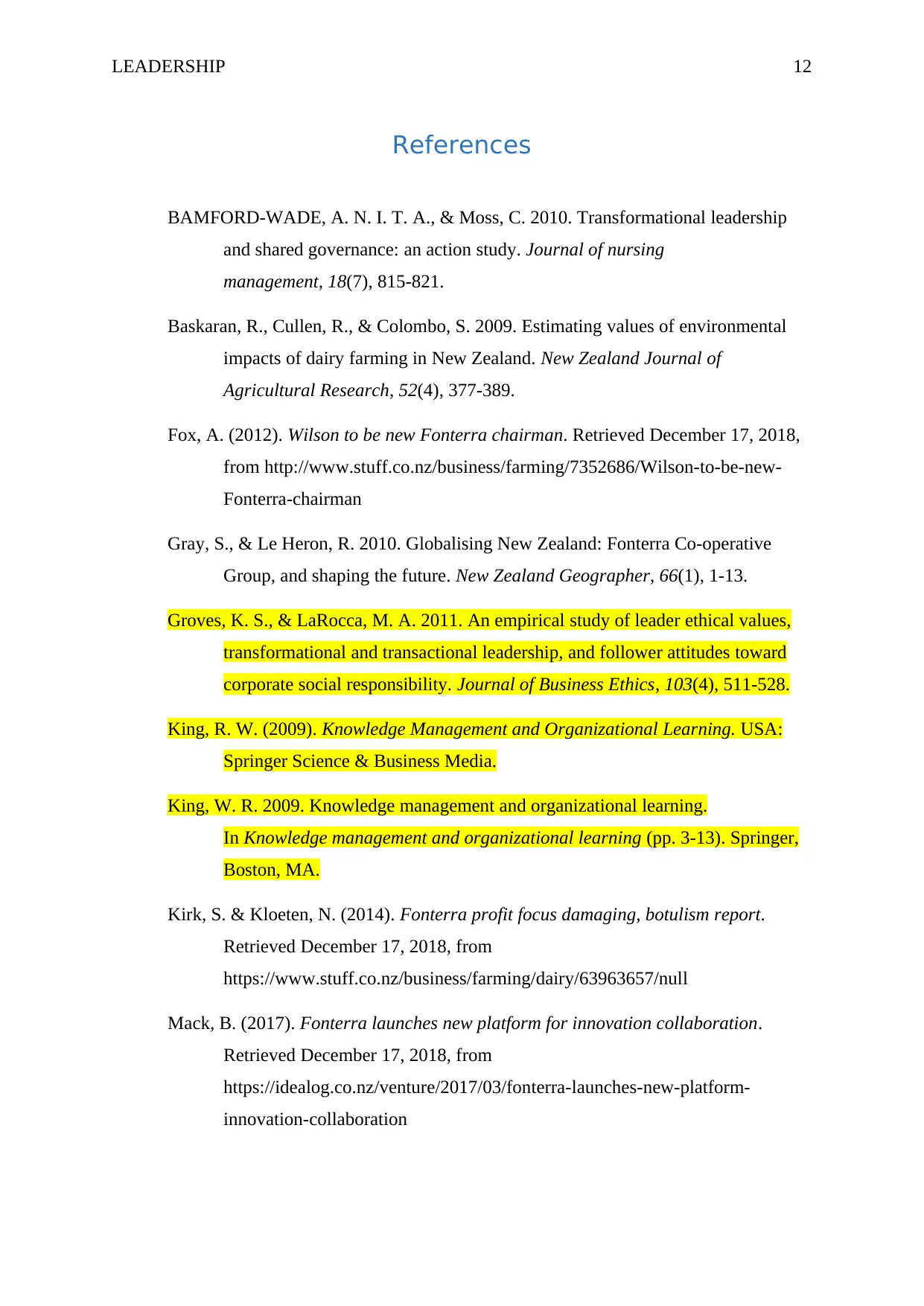
LEADERSHIP 12
References
BAMFORD‐WADE, A. N. I. T. A., & Moss, C. 2010. Transformational leadership
and shared governance: an action study. Journal of nursing
management, 18(7), 815-821.
Baskaran, R., Cullen, R., & Colombo, S. 2009. Estimating values of environmental
impacts of dairy farming in New Zealand. New Zealand Journal of
Agricultural Research, 52(4), 377-389.
Fox, A. (2012). Wilson to be new Fonterra chairman. Retrieved December 17, 2018,
from http://www.stuff.co.nz/business/farming/7352686/Wilson-to-be-new-
Fonterra-chairman
Gray, S., & Le Heron, R. 2010. Globalising New Zealand: Fonterra Co‐operative
Group, and shaping the future. New Zealand Geographer, 66(1), 1-13.
Groves, K. S., & LaRocca, M. A. 2011. An empirical study of leader ethical values,
transformational and transactional leadership, and follower attitudes toward
corporate social responsibility. Journal of Business Ethics, 103(4), 511-528.
King, R. W. (2009). Knowledge Management and Organizational Learning. USA:
Springer Science & Business Media.
King, W. R. 2009. Knowledge management and organizational learning.
In Knowledge management and organizational learning (pp. 3-13). Springer,
Boston, MA.
Kirk, S. & Kloeten, N. (2014). Fonterra profit focus damaging, botulism report.
Retrieved December 17, 2018, from
https://www.stuff.co.nz/business/farming/dairy/63963657/null
Mack, B. (2017). Fonterra launches new platform for innovation collaboration.
Retrieved December 17, 2018, from
https://idealog.co.nz/venture/2017/03/fonterra-launches-new-platform-
innovation-collaboration
References
BAMFORD‐WADE, A. N. I. T. A., & Moss, C. 2010. Transformational leadership
and shared governance: an action study. Journal of nursing
management, 18(7), 815-821.
Baskaran, R., Cullen, R., & Colombo, S. 2009. Estimating values of environmental
impacts of dairy farming in New Zealand. New Zealand Journal of
Agricultural Research, 52(4), 377-389.
Fox, A. (2012). Wilson to be new Fonterra chairman. Retrieved December 17, 2018,
from http://www.stuff.co.nz/business/farming/7352686/Wilson-to-be-new-
Fonterra-chairman
Gray, S., & Le Heron, R. 2010. Globalising New Zealand: Fonterra Co‐operative
Group, and shaping the future. New Zealand Geographer, 66(1), 1-13.
Groves, K. S., & LaRocca, M. A. 2011. An empirical study of leader ethical values,
transformational and transactional leadership, and follower attitudes toward
corporate social responsibility. Journal of Business Ethics, 103(4), 511-528.
King, R. W. (2009). Knowledge Management and Organizational Learning. USA:
Springer Science & Business Media.
King, W. R. 2009. Knowledge management and organizational learning.
In Knowledge management and organizational learning (pp. 3-13). Springer,
Boston, MA.
Kirk, S. & Kloeten, N. (2014). Fonterra profit focus damaging, botulism report.
Retrieved December 17, 2018, from
https://www.stuff.co.nz/business/farming/dairy/63963657/null
Mack, B. (2017). Fonterra launches new platform for innovation collaboration.
Retrieved December 17, 2018, from
https://idealog.co.nz/venture/2017/03/fonterra-launches-new-platform-
innovation-collaboration
Paraphrase This Document
Need a fresh take? Get an instant paraphrase of this document with our AI Paraphraser
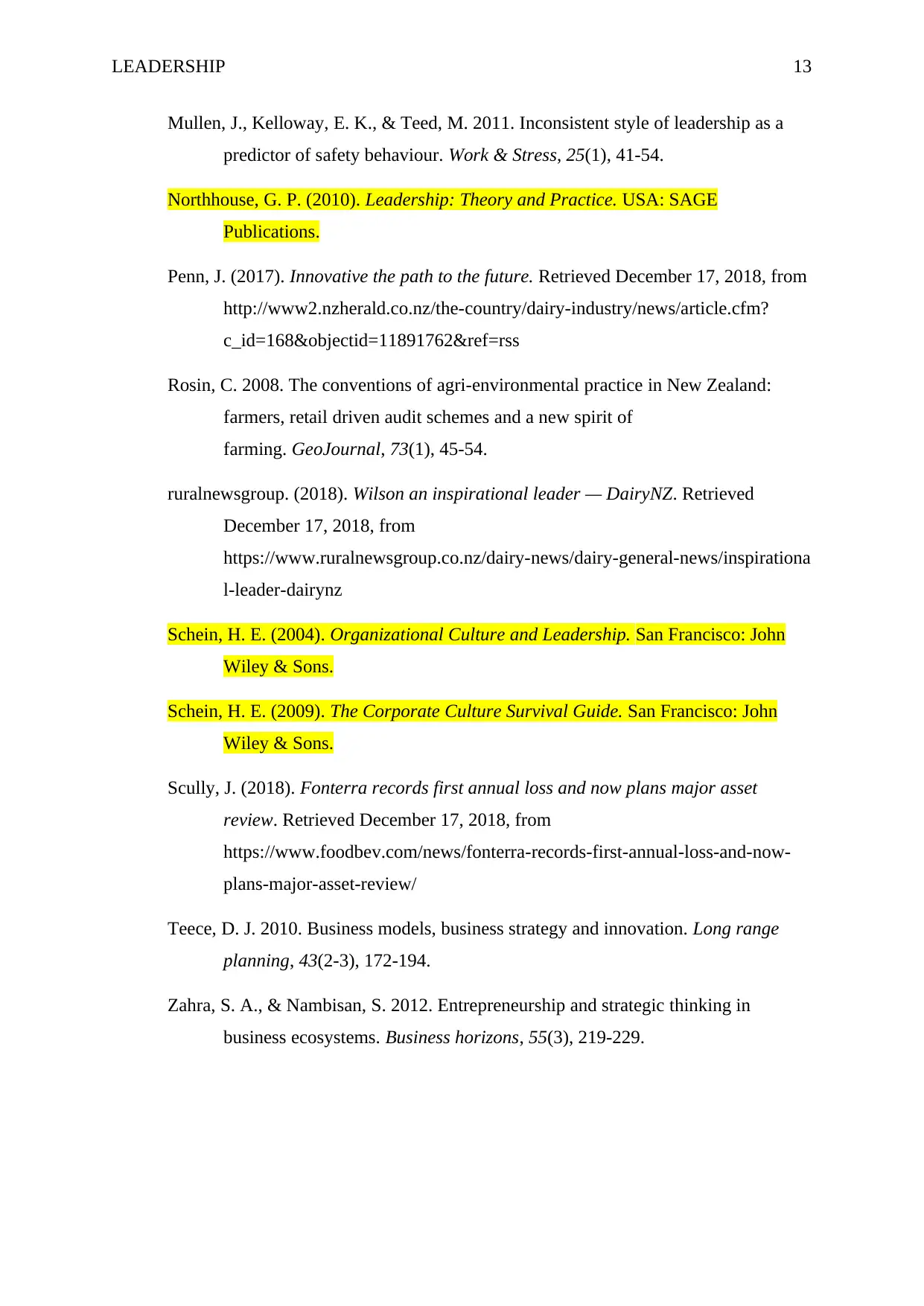
LEADERSHIP 13
Mullen, J., Kelloway, E. K., & Teed, M. 2011. Inconsistent style of leadership as a
predictor of safety behaviour. Work & Stress, 25(1), 41-54.
Northhouse, G. P. (2010). Leadership: Theory and Practice. USA: SAGE
Publications.
Penn, J. (2017). Innovative the path to the future. Retrieved December 17, 2018, from
http://www2.nzherald.co.nz/the-country/dairy-industry/news/article.cfm?
c_id=168&objectid=11891762&ref=rss
Rosin, C. 2008. The conventions of agri-environmental practice in New Zealand:
farmers, retail driven audit schemes and a new spirit of
farming. GeoJournal, 73(1), 45-54.
ruralnewsgroup. (2018). Wilson an inspirational leader — DairyNZ. Retrieved
December 17, 2018, from
https://www.ruralnewsgroup.co.nz/dairy-news/dairy-general-news/inspirationa
l-leader-dairynz
Schein, H. E. (2004). Organizational Culture and Leadership. San Francisco: John
Wiley & Sons.
Schein, H. E. (2009). The Corporate Culture Survival Guide. San Francisco: John
Wiley & Sons.
Scully, J. (2018). Fonterra records first annual loss and now plans major asset
review. Retrieved December 17, 2018, from
https://www.foodbev.com/news/fonterra-records-first-annual-loss-and-now-
plans-major-asset-review/
Teece, D. J. 2010. Business models, business strategy and innovation. Long range
planning, 43(2-3), 172-194.
Zahra, S. A., & Nambisan, S. 2012. Entrepreneurship and strategic thinking in
business ecosystems. Business horizons, 55(3), 219-229.
Mullen, J., Kelloway, E. K., & Teed, M. 2011. Inconsistent style of leadership as a
predictor of safety behaviour. Work & Stress, 25(1), 41-54.
Northhouse, G. P. (2010). Leadership: Theory and Practice. USA: SAGE
Publications.
Penn, J. (2017). Innovative the path to the future. Retrieved December 17, 2018, from
http://www2.nzherald.co.nz/the-country/dairy-industry/news/article.cfm?
c_id=168&objectid=11891762&ref=rss
Rosin, C. 2008. The conventions of agri-environmental practice in New Zealand:
farmers, retail driven audit schemes and a new spirit of
farming. GeoJournal, 73(1), 45-54.
ruralnewsgroup. (2018). Wilson an inspirational leader — DairyNZ. Retrieved
December 17, 2018, from
https://www.ruralnewsgroup.co.nz/dairy-news/dairy-general-news/inspirationa
l-leader-dairynz
Schein, H. E. (2004). Organizational Culture and Leadership. San Francisco: John
Wiley & Sons.
Schein, H. E. (2009). The Corporate Culture Survival Guide. San Francisco: John
Wiley & Sons.
Scully, J. (2018). Fonterra records first annual loss and now plans major asset
review. Retrieved December 17, 2018, from
https://www.foodbev.com/news/fonterra-records-first-annual-loss-and-now-
plans-major-asset-review/
Teece, D. J. 2010. Business models, business strategy and innovation. Long range
planning, 43(2-3), 172-194.
Zahra, S. A., & Nambisan, S. 2012. Entrepreneurship and strategic thinking in
business ecosystems. Business horizons, 55(3), 219-229.
1 out of 14
Related Documents
Your All-in-One AI-Powered Toolkit for Academic Success.
+13062052269
info@desklib.com
Available 24*7 on WhatsApp / Email
![[object Object]](/_next/static/media/star-bottom.7253800d.svg)
Unlock your academic potential
© 2024 | Zucol Services PVT LTD | All rights reserved.





